Please email me at:
Or use the form below.
[contact-form 1 “Contact form 1”]
The no-pants guide to spending, saving, and thriving in the real world.

No one likes to think about the possibility of dying too young. But knowing that potential exists, you take the smart step of protecting those you love by carrying term life insurance. But what about preventing the worst? Did you know your iPhone or Android device can call for help or record vital information if you ever find yourself in a life-threatening situation? Here are five personal safety apps that could save your life.
1) myGuardianAngel
Once this app allows you to reach all of your emergency contacts with the push of one button. You enter the contact information for anyone you would want to get in touch with if you were in any sort of emergency as soon as you download it. If you are in an emergency, the app will call your contacts, send them an e-mail with your GPS location and immediately begin recording audio and video from your phone.
2) StaySafe
This app is good for anyone who works or travels alone. You can schedule the app to automatically notify friends or family after a certain period of time when your phone is inactive. For example, you can estimate how long you expect to drive from one location to another on your own and then the phone will contact someone automatically if you are out of contact longer than expected. That way your friends will know to send help because something is wrong, even if you aren’t in a position to contact them yourself. StaySafe sends your contacts a detailed GPS location for you so that they can easily find you and bring help.
3) RESCUE
This full-service app can help you on the scene as well as notify your emergency contacts for you. If you are in trouble, you can trigger the app to sound a loud alarm that might frighten off anyone who might be planning to do you harm. The alarm can also help someone find you if you are lost or unable to move from your current location. When the alarm is triggered, the app will also send immediate notifications to your emergency contact list so that they can begin to send help right away. Emergency services such as the police and fire department can also be set for notification through the RESCUE app.
4) Night Recorder
This is a good app to have when you need to make a quick recording of your surroundings for any reason. The app can be set to begin recording at a touch. If you are stranded, you could create a recording by speaking about the landmarks you can see and explaining how you got to your current location. The recorder can then send an email of your recording to anyone on your contact list.
5) iWitness
With this app, you can instantly make video or audio recordings of your situation so that there is a permanent first-hand record of everything that happens. It is a handy tool for anyone who has been in a car accident or involved in a medical emergency because you can go back and look at the video to see exactly what happened if there is any question about it later. The app will also contact emergency services or your personal emergency contacts if you are in trouble. The built-in GPS locator will transmit your exact location so that people can find you quickly and easily.
Post by Term Life Insurance News
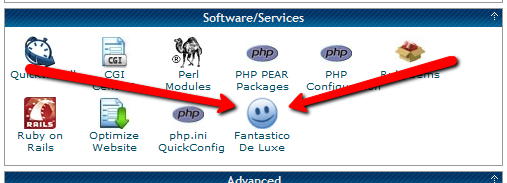
In this installment of the Make Extra Money series, I’m going to show you how to set up a WordPress site. I’m going to show you exactly what settings, plugins, and themes I use. I’m not going to get into writing posts today. That will be next time.
I use WordPress because it makes it easy to develop good-looking sites quickly. You don’t have to know html or any programming. I will be walking through the exact process using Hostgator, but most hosting plans use CPanel, so the instructions will be close. If not, just follow WordPress’s 5 minute installation guide.
Assuming you can follow along with me, log in to your hosting account and find the section of your control panel labeled “Software/Service”. Click “Fantastico De Luxe”.

On the Fantastico screen, click WordPress, then “New Installation”.
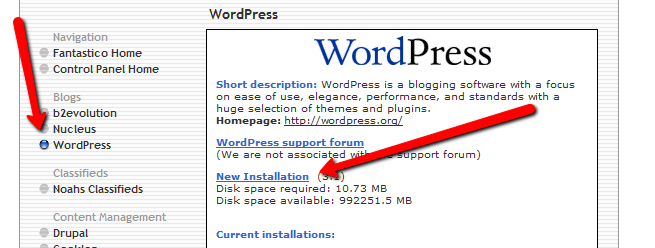
On the next screen, select your domain name, then enter all of the details: admin username, password, site name, and site description. If you’ll remember, I bought the domain http://www.masterweddingplanning.net. I chose the site name of “Master Wedding Planning” and a description of “Everything You Need to Know to Plan Your Wedding”.
Click “install”, then “finish installation”. The final screen will contain a link to the admin page, in this case, masterweddingplanning.net/wp-admin. Go there and log in.
After you log in, if there is a message at the top of the screen telling you to update, do so. Keeping your site updated is the best way to avoid getting hacked. Click “Please update now” then “Update automatically”. Don’t worry about backing up, yet. We haven’t done anything worth saving.
Next, click “Settings” on the left. Under General Settings, put the www in the WordPress and site URLs. Click save, then log back in.
Click Posts, then Categories. Under “Add New Category”, create one called “Misc” and click save.
Click Appearance. This brings you to the themes page. Click “Install Themes” and search for one you like. I normally use Headway, but before I bought that, I used SimpleX almost exclusively. Your goal is to have a simple theme that’s easy to maintain and easy to read. Bells and whistles are a distraction.
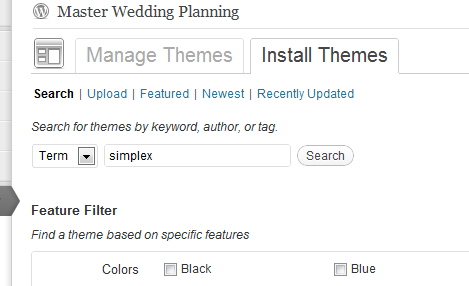
Click “Install”, “Install now”, and “Activate”. You now have a very basic WordPress site.
A plugin is an independent piece of software to make independent bits of WordPress magic happen. To install the perfect set of plugins, click Plugins on the left. Delete “Hello Dolly”, then click “Add new”.
In the search box, enter “plugin central” and click “Search plugins”. Plugin Central should be the first plugin in the list, so click “install”, then “ok”, then “activate plugin”. Congratulations, you’ve just installed your first plugin.
Now, on the left, you’ll see “Plugin Central” under Plugins. Click it. In the Easy Plugin Installation box, copy and paste the following:
All in One SEO Pack Contact Form 7 WordPress Database Backup SEO SearchTerms Tagging 2 WP Super Cache Conditional CAPTCHA for WordPress date exclusion seo WP Policies Pretty Link Lite google xml sitemaps Jetpack by WordPress.com
Click “install”.
On the left, click “Installed Plugins”. On the next screen, click the box next to “Plugins”, then select “Activate” from the dropdown and click apply.
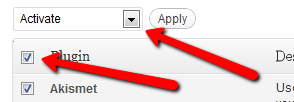
Still under Plugins, click “Akismet Configuration”. Enter your API key and hit “update options”. You probably don’t have one, so click “get your key”.
The only tool I worry about is the backup. It’s super-easy to set up. Click “Tools”, then “Backup”. 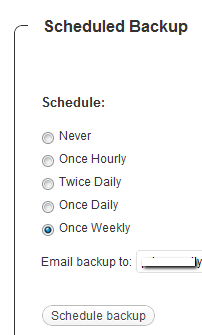
Scroll down to “Schedule Backups”, select weekly, make sure it’s set to a good email address and click “Schedule Backup”. I only save weekly because we won’t be adding daily content. Weekly is safe enough, without filling up your email inbox.
There are a lot of settings we’re going to set. This is going to make the site more usable and help the search engines find your site. We’re going to go right down the list. If you see a section that I don’t mention, it’s because the defaults are good enough.
Set the Default Post Category to “Misc”.
Visit this page and copy the entire list into “Update Service” box. This will make the site ping a few dozen services every time you publish a post. It’s a fast way to get each post indexed by Google.
Click “Save Changes”.
Uncheck everything under “Email me whenever…” and hit save. This lets people submit comments, without actually posting the comments or emailing me when they do so. Every once in a while, I go manually approve the comments, but I don’t make it a priority.
Select “Custom structure” and enter this: /%postname%/
Click save.
Set the status to “Enabled”, then fill out the site title and description. Keep the description to about 160 characters. This is what builds the blurb that shows up by the link when you site shows up in Google’s results.
Check the boxes for “Use categories for META keywords” and “Use noindex for tag archives”.
Click “Update Options”.
Check the boxes to remove each of the dates and set the alt text to “purpose” or something. This will suppress the date so your posts won’t look obsolete.
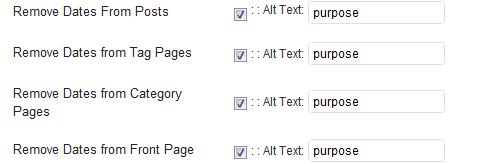
This plugin reinforces the searches that bring people to your site. It’s kind of neat. Skip the registration, accept the defaults and hit save.
Scroll to the bottom and click import. We’ll come back to this.
Select “Caching On” and hit save.
Across the top of the screen should be a giant banner telling you to connect to WordPress.com and set up Jetpack. You’ll need an account on WordPress.com, so go there and set one up. After authorizing the site, you’ll be brought back to the Jetpack configuration screen. Click “Configure” under “WordPress.com Stats”. Take the defaults and hit save.
On the contact configuration page, copy the code in the top section. You’ll need this in a moment.
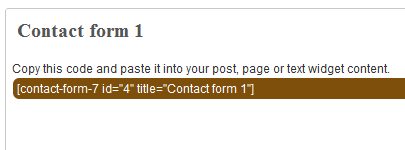
Now, we going to create a couple of static pages. On the left, click “Pages”, then “Add new”.
Name the first page “Contact” and put the contact form code in the body of the page. Hit publish.
Under Appearance, click “Menu”. Enter a menu name and hit save.
Then, under “Pages”, click the box next to “Contact”, “Disclaimer”, and any other policies you’d like to display. Hit save.
Also under Appearance, click “Widgets”. This is where you’ll select what will display in the sidebar. All you have to do is drag the boxes you want from the middle of the page to the widget bar on the right. I recommend Text, Search, Recent Posts, Popular Search Terms and Tag Cloud. In the text box, just put some placeholder text in it, like “Product will go here”. We’ll address this next time.
We’re not going to worry about getting posts in place, yet. That will be the next installment. However, the steps in the next installment could take 2 weeks to implement, and we want Google to start paying attention now. To make that happen, we need to get a little bit of content in place. This won’t be permanent content. It’s only there so Google has something to see when it comes crawling.
To get this temporary, yet legal content, I use eZineArticles. Just go search for something in your niche that doesn’t look too spammy.
Then, click “Posts”, then delete the “Hello World” post. Click “Add new”. Copy the eZine article, being sure to include the author box at the bottom, and hit publish.
To see your changes, you may have to go to Settings, then WP Cache and delete the cache so your site will refresh.
Congratulations! You now have a niche blog with content. It’s not ready to make you any money, yet, but it is ready for Google to start paying attention. In the next installment, I’ll show you how I get real unique content and set it up so Google keeps coming back to show me the love.
A few years ago, my wife and I were discussing life improvement, the options in front of us, and our future goals. She said she felt trapped by the scope of our goals and didn’t know where to start. That led to a discussion on

achieving our goals, which led to this.
Examine your life. Take stock of every aspect of your life. What pleases you? What upsets you? What do you do that adds no value to your life? Or worse, removes value? What do you do that adds the most value? What would you like to change? Eliminate? Improve? Count the small things. Nothing is insignificant. Write it all down and be specific.
Analyze your list. Are there any obvious patterns? Is there a single thread that is making you miserable or affecting multiple other items? Would eliminating 1 factor improve 90% of the rest? Is there a bad job or a toxic relationship ruining your happiness? Be honest and be critical.
What are your dreams? Where would you like to be in six months? A year? 5? 10? How would you like to retire? When? Write it all down. This is now your life plan.
Set goals. Set concrete, definable goals. Set goals that have an obvious success point. When you reach your goal, you want to be able to point it out. “Lose weight” is not a goal. “Lose 50 pounds in the next year” is a measurable, definable, concrete goal. Set incremental goals to reach your larger goals and, more importantly, your dreams.
Here’s an example:
Dream: Retire at 50.
When you are setting up your goal plan, make sure to include the analyzed items mentioned earlier. These are the things that will make today happier for you.
Now, you have examined your life. You have analyzed the results. You’ve gathered your dreams and compiled a goal plan based on your hopes, dreams, goals and desires. What’s next?
We’re going to take a page from David Allen. It’s time to Get Things Done. What do you have to do next to reach your goals? What is the next step? Don’t let yourself be overwhelmed by the scope of the entire list. Select one single item from your plan and look for the one single next step to make on the path to that goal.
Going back to the retirement goal plan, the next step towards a 10% raise could be researching salaries for your job description in your area to give you ammunition in the meeting with your boss. It could be updating your resume to hunt for a better paying job, or even just studying up on some resume tips.
If you want to run a marathon next year, the next step is to start walking every day to train your body.
If you want to improve communication with your spouse, the next step is probably to let her know.
If you want to eliminate debt, the next step may be setting up a budget or canceling unnecessary services like cable.
Every goal has a path leading to it. If that’s not true, you haven’t defined a concrete measurable goal.
Examine your life. Analyze your situation. Know WHAT you want. Know what you want to change. Set goals to get there, one step at a time. Take a single step towards your goals.
Then take another.
What are you doing to reach your goals and improve your life?
We live in a decidedly credit-centric culture. Whip out cash to pay for $200 in groceries and watch the funny looks from the other customers and the disgust from the clerk. It’s almost like they are upset they have to know how to count to run a cash register.
If someone doesn’t have a credit card, everyone wonders what’s wrong, and assumes they have terrible credit. That’s a lousy assumption to make, but it happens. For most of the last two years, I shunned credit cards as much as possible, preferring cash for my daily spending. Spending two years changing my spending habits has made me comfortable enough to use my cards again, both for the convenience and the rewards.
Having a decent card brings some advantages.
Credit cards legally provide fraud protection to consumers. Under U.S. federal law, you are not responsible for more than $50 of fraudulent charges. many card issuers have extended this to $0 liability, meaning you don’t pay a cent if your card is stolen. Trying getting that protection with a wallet full of cash.
The fraud protection makes it easier to shop online, which more people are doing every day. At this point, there is no product you can buy in person that you can’t get online, often cheaper. How would you order something without a credit card? Even the prepaid cards you can buy and fill at a store will often fail during an online transaction because there is no actual person or account associated with the card. The “name as it appears on the card” is a protective feature for the credit card processors and they dislike accepting cards without it.
If you’re going to use a credit card, you need to make a good choice on which credit card to get. There are a few things to check before you apply for a card.
Annual fee. Generally, I am opposed to getting any card with an annual fee, but sometimes, it’s worth it. If, for example, a card provides travel discounts and roadside assistance with its $65 annual fee, you can cancel AAA and save $75 per year. A good rewards plan can balance out the fee, too. I’m using a travel rewards card that has a 2% rewards plan. That’s 2% on every dollar spent, plus discounts on some travel purchases. In a few months, I’ve accumulated $500 of travel rewards for the $65 fee that was waived for the first year. The math works. A card that charges an annual fee without providing services worth several times that fee isn’t worth getting.
Interest rate. This should be a non-issue. You should be paying off you card completely every month. In a perfect world. In the real world, sometimes things come up. In my case, I was surprised with a medical bill for my son that was 4 times larger than my emergency fund. It went on the card. So far, I’ve only had to pay one month’s interest, and I don’t see the balance surviving another month, but it’s nice that I’m not paying a 20% interest rate. Unfortunately, as a response the CARD Act, the days of fixed rate 9.9% cards seems to be over.
Grace period. This is the amount of time you have when the credit card company isn’t charging you interest. Most cards offer a 20-25 day grace period, but still bill monthly. That means that you’ll be paying interest, even if you pay your bill on time. To be safe, you’ll need to either find a card that has a 30 day grace period, or pay your balance off every 15-20 days. Some of the horrible cards don’t offer a grace period of any length. Avoid those.
Activation fees. Avoid these. Always. There’s no card that charges an activation fee that’s worth getting. An activation fee is an early warning sign that you’ll be paying a $200 annual fee and 30% interest in addition to the $150 activation fee.
Other fees. What else does the card charge for? International transactions? ATM fees? Know what you’ll be paying.
Service. Some cards provide some stellar services, include concierge service, roadside assistance, and free travel services. Some of that can more than balance out the fees they charge. My card adds a year to the warranty of any electronics I buy with it, which is great.
Credit cards aren’t always evil, if you use them responsibly. Just be sure you know what you’re paying and what you’re getting.
What’s in your wallet?
It’s the end of a month, so it’s time to announce my new 30 Day Project. Last February, in 22 days, I went from having my abs cramp after doing 15 push-ups to doing a set of 100. Yes, really.
The problem is that the push-ups weren’t perfect. Funny things happen to your body when you are doing 100 push-ups. It’s hard to tell what your body is doing. I had good form for the first 80, but after that, my body wasn’t perfectly straight. I looked like a typical second grader in gym class. But I did it. They were push-ups.
I haven’t done a push-up since.
In March, I am going to get myself back up to 100 push-ups, only this time, I will only be doing perfect push-ups.
Here’s the plan, based on what worked last year:
This weekend, I established my baseline. I did as many push-ups as I could, until the point of failure. Failure for this purpose is defined as either my form faltering or me collapsing. I went until I couldn’t hold my body straight.
Starting on the first, I will be doing 5 sets of push-ups, twice a day.
Set 1: One half of my baseline. Starting from 24 push-ups, this set will be 12 push-ups. As I progress, this set will never be more than 20 push-ups. It is the warm-up set, after all.
Sets 2-4: ¾ of my baseline, so 18 to start.
Set 5: Go to failure. Once again, failure is defined as faulty from. This will establish my baseline for the next session.
If I don’t progress for 3 days, I will take a day off to recover and–given previous experience–come back with some serious improvement.
This is a self-correcting progression. If I can’t meet the previous day’s baseline, my last set will be lower, which will lower the baseline for the following session.
An interesting question I have is how it will affect my diet. I haven’t been exercising at all, to see how well the slow carb diet does on it’s own. Now, I’m going to be adding an aggressive exercise plan on top of it. A plan that involves a bit of muscle bulking. I’m guessing that my weight loss will slow down a lot, but I will shed inches like mad. I will be tracking my progression, and my weight and measurements. The graphs should be fun.
I am on the Slow Carb Diet. At the end of the month, I’ll see what the results were and decide if it’s worth continuing. For those who don’t know, the Slow Carb Diet involves cutting out potatoes, rice, flour, sugar, and dairy in all their forms. My meals consist of 40% proteins, 30% vegetables, and 30% legumes(beans or lentils). There is no calorie counting, just some specific rules, accompanied by a timed supplement regimen and some timed exercises to manipulate my metabolism. The supplements are NOT effedrin-based diet pills, or, in fact, uppers of any kind. There is also a weekly cheat day, to cut the impulse to cheat and to avoid letting my body go into famine mode.
I’m measuring two metrics, my weight and the total inches of my waist , hips, biceps, and thighs. Between the two, I should have an accurate assessment of my progress.
Weight: I have lost 33 pounds since January 2nd! That’s 3 pounds since last week. Only 9 more to meet my goal for February. Oh wait. I won’t be hitting it this month.
Total Inches: I have lost 17 inches in the same time frame, down half an inch since last week.
I’ve got some codes for H&R Block Premium Online. It’s federal only and the state return costs an extra $35, but that’s still a screaming deal. Premium handles small business and investment tax issues. If you want to get it, leave a comment saying so. First come, first serve, until I’m out of codes.
Yes, I Am Cheap has a post about growing up poor.
Public Service Announcement: Liquidation sales are rarely good deals. When one store in a chain closes, the profitable merchandise always gets shipped to another store. The rest of it will often get marked up, in anticipation of people shutting off their critical thinking skills in the face of big “On Sale” signs.
I’ve found a new life goal: underground glowworm cave tubing. Wow.
OpenLibrary is offering up 80,000 ebooks to borrow, for free. 10,000 of them are still in copyright. I need a kindle.
This is where I review the posts I wrote a year ago. Did you miss them then?
A few years ago, I sold a truck(on payments) to a friend, who promptly quit paying me and disappeared. I ended up playing repossessing the truck.
There was also a story about how I convinced two big companies that collecting on me for a bill of more than $800 wasn’t worth the effort. It was good, because I didn’t make the call.
Slow Carb Diet: How to Avoid Going Bat-**** Crazy was included in the Festival of Frugality.
Three Alternatives to a Budget was included in the Totally Money Carnival.
Protect your home was included in the Carnival of Personal Finance.
Budgets Are Sexy ran my post, Side Hustle Series: I’m a Gun Permit Instructor. I forgot to link back to this, last week.
Prairie EcoThrifter ran my post, The Luxury of Vacation for the Yakezie Blog Swap.
Thank you! If I missed anyone, please let me know.
Eric hosted the Yakezie Blog Swap, which is a bunch of bloggers writing on the same topic and sharing the posts with each other. Here is his list of the participants this round.
I wrote about my journey to become a DJ at Beating Broke.
Beating Broke wrote about shoe shopping at Narrow Bridge.
Barbara Friedberg got a really nice couch and shared the experience at Wealth Informatics.
Suba doesn’t think the rent is too damn high, in fact, Suba thinks it is worth it and shares at Barbara Friedberg Personal Finance.
Mr. and Mrs. BP spent a lot when they got a dog. Read about it at 101 Centavos.
101 Centavos went nuts on an anniversary, but you know what that can get you… Read about it at Broke Professionals.
Latisha Styles’ post at Bucksome Boomer is I Spent How Much?! My Birthday Trip to the Bahamas.
Kay Lynn spent her heart out on a new car with all the bells and whistles and you can read about it at Financial Success for Young Adults.
Derek got a sweet new digital camera and tells us about it at My Personal Finance Journey.
Jacob has splurged a couple of times on travel and outdoor gear and has no regrets and shares the experiences at My Life and Finances.
Miss T. likes to splurge on travel. We have something in common. The difference? She wrote about it at Live Real Now.
Jason is a fan of the luxury of vacation. You can read about it at the Prairie EcoThrifter.
Squirrelers went to Europe for three weeks. Totally worth it! Read about it at Money Sanity.
Money Sanity likes good champagne. I can’t judge, I like good Scotch. Read about why at Squirrelers.
Melissa took 10 days and took the trip of a lifetime to visit a friend in China. Read about it at The Saved Quarter.
The Saved Quarter bought a Blendtec blender. Yes, the blender from “will it blend.” The story is at Mom’s Plan. (In case you were wondering, this blender can blend anything. Well, anything but Chuck Norris.)
There are so many ways you can read and interact with this site.
You can subscribe by RSS and get the posts in your favorite news reader. I prefer Google Reader.
You can subscribe by email and get, not only the posts delivered to your inbox, but occasional giveaways and tidbits not available elsewhere.
You can ‘Like’ LRN on Facebook. Facebook gets more use than Google. It can’t hurt to see what you want where you want.
You can follow LRN on Twitter. This comes with some nearly-instant interaction.
You can send me an email, telling me what you liked, what you didn’t like, or what you’d like to see more(or less) of. I promise to reply to any email that isn’t purely spam.
Have a great week!